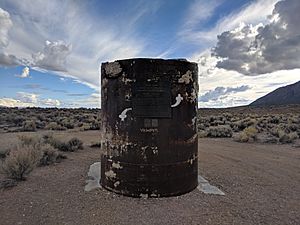Operation Crosstie facts for kids
Quick facts for kids Operation Crosstie |
|
|---|---|

Crosstie Buggy, a row excavation test using five detonations in a row
|
|
| Information | |
| Country | United States |
| Test site |
|
| Period | 1967–1968 |
| Number of tests | 48 |
| Test type | cratering, underground shaft, tunnel |
| Max. yield | 1.3 megatonnes of TNT (5.4 PJ) |
| Navigation | |
| Previous test series | Operation Latchkey |
| Next test series | Operation Bowline |
Operation Crosstie was a series of 48 nuclear tests carried out by the United States. These tests happened between 1967 and 1968 at a place called the Nevada Test Site. This series of tests came after Operation Latchkey and before Operation Bowline.
Contents
Understanding Operation Crosstie
Operation Crosstie was a group of experiments. Scientists wanted to learn more about how nuclear explosions worked underground. They also explored using these explosions for peaceful projects.
Project Gasbuggy: Natural Gas Experiment
One important test in Operation Crosstie was called Gasbuggy. This was an underground explosion. Its goal was to help get more natural gas out of the ground. The idea was that the explosion would crack the rock deep below. This would let the gas flow out more easily.
The test worked as planned. However, it didn't increase the gas production as much as hoped. Also, the gas became slightly radioactive. Because of this, people didn't want to buy the gas.
Project Buggy: Digging a Channel
Buggy was another interesting test. It was part of a program called Operation Plowshare. This program looked into using nuclear explosions for big construction jobs. The Buggy test aimed to dig a channel in the ground.
How Buggy Worked
Five nuclear devices were exploded at the same time. They were placed 150 feet (about 46 meters) apart. Each device was 150 feet (about 46 meters) below the surface. The explosions created a channel. This channel was about 300 feet (91 meters) wide. It was also 900 feet (274 meters) long and 80 feet (24 meters) deep.
The Soviet Union also did a similar test. They wanted to see if nuclear explosions could help build a canal. This was for the Pechora–Kama Canal project.
Project Faultless: Testing the Ground
The Faultless test was a very powerful underground explosion. It happened 3,200 feet (about 975 meters) deep in a mine. This was near Tonopah, Nevada. The explosion had a yield of about 1 megaton. That's like a million tons of TNT!
Why Faultless Was Important
The main reason for this test was to check the ground. Scientists wanted to know if the area was strong enough. They planned to test an even bigger nuclear bomb there. This bomb was a 5-megaton warhead for the Spartan missile.
However, the test didn't go well. The ground around the explosion cracked a lot. This showed that the land was not suitable for very large nuclear tests. So, they decided to do a similar test somewhere else. This next test happened at Amchitka Island, Alaska, in 1969.
What Remains at the Site
Today, an 8-foot (2.4-meter) wide steel pipe is still at the test site. This pipe was used to lower the bomb into the ground. After the explosion, the ground around the pipe sank by nine feet (2.7 meters). A special plaque is now on the exposed pipe. It helps people remember the event.
Images for kids



